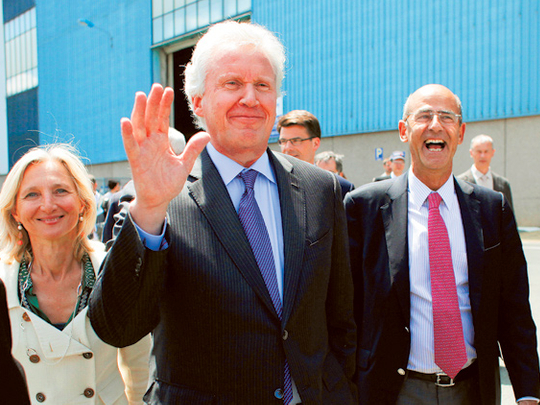
New York
Investor support for large acquisitions and a desire to trump rivals in consolidating markets have led chief executives to strike big transactions so far in 2014, raising year-to-date global deal volumes to their highest level in seven years. Corporate buyers did not shy away from going hostile if their targets proved unwilling to sell, while more US companies rushed to buy overseas peers to lower tax rates and access cash held offshore in a practice known as inversion.
The deal making frenzy could last for several months absent geopolitical or economic shocks, with buyers keen to take advantage of their strong stock prices, ample cash reserves and cheap available financing.
“Companies have strategic imperatives to do deals, they have the cash to do deals, and they can borrow additional cash at record-low rates,” said Frank Aquila, a mergers and acquisitions lawyer at Sullivan & Cromwell LLP. “It really is a bit of a perfect storm when it comes to deal making.” Unlike the most recent heyday of deal making, which was back in 2007 when private equity used cheap money to load up companies with debt, this year’s merger boom is being led by cash-rich corporations with strong balance-sheets, such as Pfizer Inc, Comcast Corp and General Electric Co.
“What is notable about the deal activity we have seen in the first half of the year is the blue-chip nature of the companies who are doing the acquiring. We have finally seen the return of the strategic acquirer,” said Gregg Lemkau, co-head of global mergers and acquisitions at Goldman Sachs Group.
Year-to-date global deal volume as of June 26 surged to $1.75 trillion, up 75 per cent from the year-ago period, according to Thomson Reuters data. That was the highest level since 2007, when deal volume reached $2.28 trillion. This year’s increase came despite the number of global deals dropping slightly to 17,698 from 17,820 the year before.
At over $1 trillion, the second quarter of 2014 was the highest in deal volume since the second quarter of 2007 and was up significantly from the $680 million in the first quarter of 2014. Thirty-eight unsolicited or hostile bids, worth more than $150 billion, were launched in the first six months of the year, compared with 19 such deals worth $8 billion in the same period last year.
Pfizer made an abortive $118 billion bid for AstraZeneca Plc, Valeant Pharmaceuticals International Inc is trying to buy Botox maker Allergan Inc for more than $50 billion, and AbbVie Inc plans to appeal to Shire Plc’s shareholders after an unsolicited $46 billion bid was rebuffed.
“With both the target and acquirer’s stock generally up after deals are announced, buyers see value creation and tend to be more aggressive even if targets are not willing to sell,” said Ravi Sinha, executive vice-chairman of global corporate and investment banking at Bank of America Merrill Lynch.
More CEOs and boards are willing to pull the trigger on transactions that have been contemplated for a while, with a view that financing conditions are at their peak and unlikely to improve, said Marc-Anthony Hourihan, co-head of Americas M&A at UBS AG.
Risk-taking has been generally rewarded by investors, at a time when low cost of capital means buyers can obtain immediate boosts to their earnings from those deals.
Nearly 70 per cent of announcements of US acquisitions worth $1 billion or more in the first half were followed by gains in the stock prices of the buyers, up from 60 per cent in the same period last year and compared with a seven-year average of 55 per cent, Thomson Reuters data showed.
“In the early stages of an M&A wave, the returns to acquirers tend to be positive, but as the M&A wave matures, the returns turn negative as people get overconfident,” said Bob Bruner, dean of the University of Virginia’s Darden Graduate School of Business Administration. “It would seem that we are still at the early stage of the wave.”
With stock markets at record-high levels, the average premium buyers paid over target companies’ four-week stock prices was 24.8 per cent so far this year, down from 28.1 per cent in the same period last year and 30.3 per cent in 2012. But on an earnings before interest, tax, depreciation and amortisation (Ebitda) basis, valuations climbed.
Buyers on average paid targets 13 times Ebitda in the first-half of the year, compared with 11.8 times in the same period last year. That was the highest level since 2008, according to Thomson Reuters data.
“On an (earnings per share) accretion basis, nearly every deal looks great. However, on a return-on-invested-capital basis, values appear pretty high,” Goldman Sachs’ Lemkau said.
“Many boards are being forced to think about whether their traditional return on invested capital thresholds remain appropriate in an environment where the cost of capital is so low,” he added.
The red-hot equity markets and rising deal valuations have forced buyout firms to the sidelines, with private equity-backed leveraged buyouts declining 9 per cent to $120.3 billion so far this year, representing 7 per cent of the M&A market. Private equity firms, however, took advantage of the M&A boom to sell more of their companies for top-dollar amounts.
“It’s a great debt market but the issue for private equity is that it has inability to do highly levered transactions, compared to the leverage levels in 2006 and 2007, given the federal limitations,” UBS’s Hourihan said.
Goldman Sachs was the top M&A adviser worldwide, with $623 billion worth of deals so far this year. Morgan Stanley, Bank of America Merrill Lynch, Citigroup Inc and JPMorgan Chase & Co rounded out the top five.












